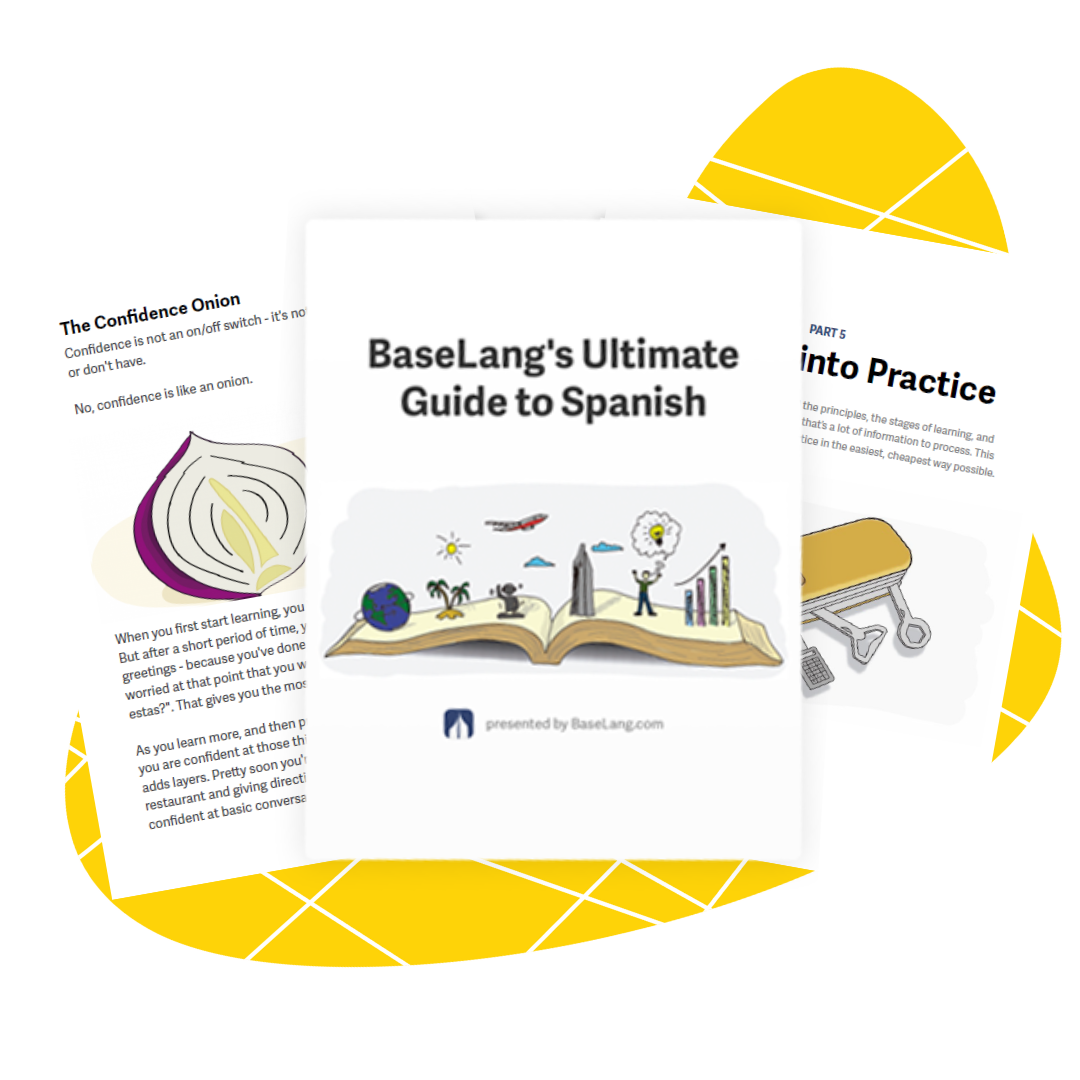Reflexive verbs In Spanish: The only guide you need

Get our free email course, Shortcut to Conversational.
Have conversations faster, understand people when they speak fast, and other tested tips to learn faster.
More infoReflexive verbs in Spanish are used all the time, and can take several forms. Mastering them is an important step in becoming a competent speaker, so we bring you this updated guide to show how and when to use reflexive verbs in Spanish.
We’ll go step by step, starting at the beginning with what is a reflexive verb. We’ll introduce the reflexive pronouns, and we’ll see where to place them in different types of sentences. Then we’ll focus on the three major types of reflexive pronouns in Spanish: natural reflexives, reciprocal reflexives, and non-reflexive verbs that can be used reflexively.
As we do in all our lessons, we’ll provide plenty of examples to demonstrate how to use reflexive verbs in Spanish. We’ll also provide a list of reflexive verbs in Spanish for each of the three types. So without further ado, let’s get started!
What is a reflexive verb in Spanish?
In simple terms, reflexive verbs in Spanish are used when a person performs an action on, for, or to themself.
For example, I wake (myself) up, he gets (himself) dressed, she showered (herself), and so on.
In other words, both the subject and the indirect object of a reflexive verb are the same person or thing.
This means that the subject pronouns (yo, tú, él, ella, usted, nosotros, nosotras, vosotros, vosotras, ellos, ellas, ustedes) will always be affected by the action, and will match the reflexive pronouns (me, te, se, nos, os, se). We’ll go into more detail on the reflexive pronouns below.
How do you identify a reflexive verb?
As we’ll cover later in this post, reflexive verbs come in many forms.
We can identify reflexive verbs by their verb endings in the infinitive verb form: Spanish reflexive verbs always end in se, which is the neutral reflexive pronoun. Examples are conocerse (to know each other), llamarse (to call oneself), or maquillarse (to put makeup on oneself).
Before we see our first list of reflexive verbs in Spanish, however, we need to take a slight detour to review the reflexive pronouns.
What is a reflexive pronoun?
The reflexive pronoun is key to identifying reflexive verbs. All Spanish reflexive verbs require a reflexive pronoun; otherwise they’re not reflexive verbs!
In many cases the verb will mean something else if it doesn’t have a reflexive pronoun. Sometimes it won’t even make any sense at all!
Let’s take the verb bañar, which means to bathe. In its reflexive form we add the reflexive pronoun se: bañarse becomes a reflexive verb meaning to bathe oneself.
We’ll cover more verbs like this later. For now, let’s focus on each reflexive pronoun and how to use them.
What are the six reflexive pronouns in Spanish?
There are actually only five reflexive pronouns in Spanish that you need to learn, since se is the same third-person pronoun for both singular and plural. Here we present all the reflexive pronouns Spanish uses, organized by grammatical person.
| Reflexive pronouns, Spanish | Singular | Plural |
| First-person | me | nos |
| Second-person | te (se) | os (se) |
| Third-person | se | se |
Note that we’ve only included se as second-person pronouns when they refer to usted or ustedes, which both mean you in Spanish. In Spanish grammar, these are considered third-person pronouns, with their corresponding third-person verb conjugations. Os is rarely used outside of Spain since it corresponds to vosotros and vosotras, which are the second-person plural pronouns for you. We explain the differences between all of these in our detailed post on You in Spanish.
The reflexive pronouns in English generally end in -self or -selves, as in myself or yourselves. We’ll also see how reflexive pronouns can be used reciprocally, with translations closer to one another or each other. In many cases, the English pronoun is omitted entirely from the translation, even when it’s required in Spanish.
We have a dedicated lesson on Spanish reflexive pronouns where we go into a lot more detail, but this is enough for now so you know what they are. Now we’re ready to see how to use them.
Where to place reflexive pronouns in a sentence
Reflexive pronouns are typically placed before conjugated verbs.
- Tú te afeitas todas las semanas. – You shave (yourself) every week.
- Yo me despierto a las 6 de la mañana. – I wake (myself) up at 6am.
For negative commands, the reflexive pronoun is placed between the Spanish negation word no and the conjugated verb.
- No se preocupen, todo está bien. – Don’t worry (guys), everything is fine.
There are a few sentence structures where reflexive pronouns don’t have to be placed before the conjugated verbs. We’ll introduce each one here before we move on to the three categories of Spanish reflexive verbs.
When we have a sentence that includes an infinitive verb form, the pronoun can be placed before the conjugated verb or attached to the end of the infinitive verb.
- No se van a saludar. – They won’t say hello to each other.
- No vas a salirte con la tuya. – You are not going to get away with it.
The same placement applies when we use the progressive verb forms (equivalent to -ing in English): either before the conjugated auxiliary verb (usually estar) or attached to the end of the gerund.
- Me estaba duchando cuando me llamaste. – I was showering when you called.
- Estaba lavándome la cara, perdona. – I was washing my face, sorry.
We saw above that with negative commands, we place the reflexive pronoun before the conjugated verb. With affirmative commands in Spanish, on the other hand, we attach the reflexive pronoun directly to the end of the conjugated verb.
- Levántate temprano mañana, es un día importante. – Wake up early tomorrow, it’s an important day.
Now that we’ve seen a basic explanation of reflexive verbs, we can examine their use in further detail.
What are the three types of reflexive verbs in Spanish?
Spanish reflexive verbs can be broken down into three main categories: natural reflexives, reciprocal reflexives, and non-reflexive verbs. We’ll look at each one in turn in the next sections.
Natural reflexives are verbs which are easily identified as reflexive, since the pronoun se is attached to the infinitive (dormirse, bañarse, arrepentirse).
- Me arrepiento de todo lo que hice. – I regret everything I have done.
Reciprocal reflexives are used to describe an action being performed by two or more people at the same time, and normally on each other.
- Patricia y Ana se maquillan antes de salir. – Patricia and Ana put makeup on each other before going out.
Many non-reflexive verbs can still be used with reflexive pronouns, in which case they take on a different meaning. For example, volver is a non-reflexive verb meaning to return, while volverse means to become.
- Yo vuelvo a Asia la próxima semana. – I return to Asia next week.
- Ellos se volvieron amigos después de unos años. – They became friends after a couple of years.
So how do you use reflexive Spanish verbs? The answer to this question will depend on which type of reflexive verb you are using. Let’s take a look at each of these three categories to see how to use reflexive verbs in Spanish.
Natural Reflexives
Natural reflexives are what first come to mind when we think of reflexive verbs in Spanish, since many describe actions that people generally do on themselves. In other words, these are the Spanish verbs that are most commonly used for reflexive actions.
Many of these natural reflexives can be classed as routine verbs, since we use them when speaking about daily actions, routines, and personal care. These verbs are reflexive by nature, since they’re used to describe an action being performed on the subject.
Some natural reflexives can still be used as non-reflexive verbs in Spanish. They often keep the same meaning, but describe the action being performed on somebody else than the subject. In these cases, we use direct object pronouns instead of reflexive pronouns.
For example, in this first sentence we use the reflexive form of afeitarse (to shave) to indicate that the subject is doing the action for themself.
- Yo me afeito la barba en la mañana. – I shave my beard in the morning.
When we use the same verb in its non-reflexive form afeitar, we indicate that the direct object of the verb’s action is somebody different from the subject who is performing the action.
- Yo afeito la barba de mi abuelo en la tarde. – I shave my grandfather’s beard in the afternoon.
You may have noticed that when we use these reflexive verbs to talk about an action we do on ourselves like shaving, we don’t use the possessive adjective in Spanish. Instead, we just use the indefinite article along with the reflexive pronoun to convey the same meaning: “yo me afeito la barba” means “I shave my beard.” We explain this more in our post on possessive adjectives in Spanish.
Reflexive verbs for daily actions
Now, let’s review the most common reflexive verbs for speaking about daily actions. Notice that the non-reflexive forms mostly have the same meaning, except that they need to have a different direct object.
To compare these reflexive vs non-reflexive verbs we could say that the former usually includes oneself while the latter can include someone else (as in to shave oneself vs to shave someone else for afeitarse vs afeitar, for example)
| Reflexive verbs, Spanish | English | Non reflexive verbs, Spanish | English | |
| acostarse | to lie down, to go to bed | acostar | to lay down | |
| afeitarse | to shave oneself | afeitar | to shave | |
| bañarse | to bathe oneself | bañar | to bathe | |
| cepillarse | to brush oneself | cepillar | to brush | |
| despertarse | to wake up | despertar | to wake up, to rouse | |
| dormirse | to fall asleep, to go to sleep | dormir | to sleep | |
| lavarse | to wash oneself | lavar | to wash | |
| maquillarse | to put makeup on oneself | maquillar | to put makeup on | |
| peinarse | to comb oneself’s hair | peinar | to comb | |
| sentarse | to sit, to take a seat | sentar | to seat |
Now let’s see a few examples of how to use these reflexive Spanish verbs for daily routines.
- Siéntate acá, ya vuelvo. – Sit here, I’ll be right back.
- Siempre me ha gustado cepillarme antes de bañarme. – I have always liked to brush my hair before taking a bath.
- Ve a vestirte para salir temprano. – Go and get dressed so that we can leave early.
- Tú puedes acostarte en el sofá toda la noche si quieres. Yo prefiero dormirme en mi cama. – You can lie on the couch all night if you want. I prefer to fall asleep in my bed.
Reflexive verbs for emotions and moods
Another set of natural reflexives are used to describe emotions and moods. In their reflexive forms, these verbs refer to the feelings of the subject. Non-reflexively, the same verbs generally need a direct object.
Here are some of the most common Spanish reflexive verbs for emotions, along with their non-reflexive counterparts.
| Reflexive verbs, Spanish | English | Non reflexive verbs, Spanish | English | |
| aburrirse | to get bored | aburrir | to bore | |
| alegrarse | to be pleased, to be happy | alegrar | to cheer up, to lighten up | |
| asustarse | to get scared, to be frightened | asustar | to scare, to frighten | |
| cansarse | to get tired, to tire | cansar | to tire, to annoy | |
| divertirse | to enjoy onself, to have a good time | divertir | to amuse | |
| sentirse | to feel (psychological) | sentir | to feel (physical) |
Let’s see a few examples with these reflexive verbs of emotion.
- Me alegra mucho que vengas. – It makes me happy that you’re coming.
- La niña se divierte con el gatito. – The girl amuses herself with the kitten.
- Me siento menos solo con muchas plantas en casa. – I feel less alone with many plants in the house.
Now compare the previous examples with these next ones where we use the non-reflexive forms of the same verbs. The meanings are similar, but they require direct objects to understand who or what is being affected by the verb’s action.
- Tú alegras mi día. – You brighten up my day.
- El gatito divierte a la niña. – The kitten amuses the girl.
- Siento la tierra antes de regar las plantas. – I feel the soil before watering the plants.
Truly natural reflexives
The final set of verbs we’ll mention in this section can only be used with the reflexive pronouns. There are no non-reflexive versions of these verbs, so they are truly natural reflexives.
Unlike the other Spanish verbs we saw in the previous lists, these verbs don’t have another meaning if we use them without reflexive pronouns; instead, they just won’t make any sense.
| Reflexive verbs, Spanish | English |
| adentrarse | to enter |
| adormilarse | to doze off |
| adueñarse | to take ownership |
| arrepentirse | to regret |
| casarse | to get married |
| desvestir | to get undressed |
| desinteresarse | to become disinterested, to lose interest |
| dignarse | to condescend |
| suicidarse | to commit suicide |
| quitarse | to take off |
Let’s see a few examples of how these reflexive verbs are used.
- Estabas adormilándote en el viaje hacia acá. – You were getting sleepy on the way here.
- Debes arrepentirte de perder tanto tiempo en eso. – You must regret wasting so much time on that.
- Este otoño, mi hermano se casa con su novia de la universidad. – This fall, my brother is marrying his sweetheart from university.
- Ella se desinteresó una vez que descubrió mi edad. – She became disinterested once she found out my age.
To be honest, we’ve simplified things a bit by grouping these different Spanish reflexive verb lists together under the same banner of natural reflexives. We go into a lot more detail on how they differ in our advanced grammar post on all the different uses of Se in Spanish. For today’s lesson though, this grouping is adequate for understanding how to use reflexive verbs in Spanish.
Reciprocal reflexive verbs
As their name suggests, reciprocal reflexives are verbs that describe actions that two or more subjects perform on each other at the same time. Since the action is reciprocal, we always have a plural subject and use the corresponding plural reflexive pronoun: nos, os, or se.
Here’s a list of Spanish verbs that are common reciprocal reflexives. We’ll use each one in an example below.
| Reciprocal reflexive verb, Spanish | English |
| conocerse | to know each other |
| saludarse | to say hello to each other, to greet each other |
| golpearse | to hit each other |
| contarse | to recount to each other, to tell one another |
| lastimarse | to hurt each other |
| pelearse | to fight each other |
| insultarse | to insult each other |
- Paolo y Sofía se conocen hace mucho tiempo. – Paolo and Sofía know each other since a long time.
- Ellos se saludan en la oficina. – They say hello to each other at the office.
- Los peleadores se golpean fuerte. – The fighters hit each other hard.
- Raquel y yo nos contamos todo – Raquel and I tell each other everything.
- Los competidores se lastiman. – The competitors hurt each other.
- Carlos y yo nos peleamos casi todos los días. – Carlos and I fight one another almost every day.
- Ellas se insultan por el chico. – They insult each other because of the boy.
You’ll notice that the closest English translation for reciprocal reflexives is: action verb + each other.
Don’t try to translate each other in Spanish with additional reciprocal words or phrases like entre sí or el uno al otro. The reciprocal reflexive pronouns already tell us that the action is being performed by the two subjects on each other.
The only reason you might use these words is to place emphasis on who is receiving the action.
- Patricia y Damián se aman el uno al otro. – Patricia and Damián love each other.
Even when we don’t add an additional each other, the sentence is understood as a reciprocal action just by properly using the reflexive pronouns.
- Joseph y yo nos saludamos en la mañana. – Joseph and I said hello to each other in the morning.
Finally, we should mention that other Spanish verbs that aren’t typically reciprocal verbs can, in the right context, be used this way to indicate a reciprocal action when two or more subjects are involved.
- Franco y Bianca se comen a besos. – Franco and Bianca eat each other up with kisses.
- Mis amigos se adivinaban los pensamientos. – My friends guessed each other’s thoughts.
This brings us to our final category of reflexive verbs in Spanish, which are normally non-reflexive but can still be used reflexively sometimes.
Non-reflexive verbs
As you may have guessed, verbs that are used without reflexive pronouns are considered non-reflexive verbs in Spanish. However, many non-reflexive verbs also have reflexive counterparts. We’ll take a look at these reflexive vs non-reflexive verbs here.
These verbs are ones that can easily land you in trouble, since most of the time the meaning of the verb changes as well – sometimes drastically.
Whether the verb takes a reflexive pronoun or not directly affects who is concerned by the verb’s action. With a reflexive pronoun, the verb affects the subject just like the natural reflexives we saw earlier. Without a reflexive pronoun, the action of the verb affects a direct object that is different from the verb’s subject.
As an example, let’s look at what happens to the non-reflexive verb levantar (to pick up, to lift) when we add reflexive pronouns to make it levantarse (to get up).
- Andrea levanta los libros. – Andrea picks up the books.
- Andrea se levanta temprano. – Andrea gets up early.
In the first non-reflexive example, Andrea’s action is affecting the books. In the next reflexive example, Andrea’s action is affecting herself.
Now let’s see a list of non-reflexive verbs that have distinct reflexive counterparts.
| Reflexive verbs, Spanish | English | Non-reflexive verbs, Spanish | English | |
| acercarse | to get closer | acercar | to bring closer | |
| caerse | to fall down, to fall over, to fall out | caer | to fall, to fall for | |
| encontrarse | to find (someone) | encontrar | to find | |
| irse | to leave | ir | to go | |
| levantarse | to get up | levantar | to pick up, to lift | |
| llamarse | to be called, to be named | llamar | to call | |
| negarse | to decline, to refuse | negar | to deny | |
| ocuparse | to take care of (something) | ocupar | to occupy, to fill | |
| perderse | to become lost, to miss something | perder | to lose | |
| referirse | to refer | referir | to narrate | |
| retirarse | to back out, to retire | retirar | to remove | |
| reunirse | to gather, to get together | reunir | to collect | |
| secarse | to dry off | secar | to dry | |
| volverse | to become | volver | to return | |
| ponerse | to put on | poner | to put | |
| quedarse | to stay | quedar | to set a meeting, to agree on (something) |
As you can see in this table, many non-reflexive verbs in Spanish take on a completely different meaning when used with reflexive pronouns.
This naturally causes a lot of confusion when you mistakenly misuse reflexive pronouns.
Let’s see a few more examples where we use the reflexive and non-reflexive verbs distinctly.
- Ese mueble ocupa mucho espacio en la sala de estar. – That piece of furniture takes up too much space in the living room.
- Yo me ocupo de sacarlo de aquí. – I’ll take care of getting it out of here.
- Ella pone las llaves sobre la mesa al llegar del trabajo. – She lays her keys on the table when she comes home from work.
- Ella se pone un vestido para ir a trabajar. – She puts on a dress to go to work.
- Danilo retira sus ahorros del banco. – Danilo withdraws his savings from the bank.
- Él no se retira de la carrera aunque va de último. – He doesn’t drop out of the race even though he is in last place.
Conclusion: Reflexive verbs in Spanish
This wraps up our full guide on how to use reflexive verbs in Spanish. Let’s do a quick recap before we go. Once you’re through, we’ll leave you with a set of exercises where you can practice conjugating reflexive verbs with the right reflexive pronouns.
We started today’s lesson with a basic rundown to explain what are reflexive pronouns in Spanish. We saw that they come in many forms, but the main unifier is that they always have the pronoun se attached to the end of their infinitive form. We also learned all of the reflexive pronouns in Spanish that correspond with each grammatical person (me, te, se, nos, os, se).
Once we’d seen the basics on sentence structure, we went into more detail on the different categories of reflexive pronouns Spanish has. We explained the particularities of each category, providing Spanish verb lists for each one. You should now be able to recognize the differences between reflexive verbs for daily routine, for emotions, and for reciprocal actions, for example. You’re also familiar with the different meanings that many non-reflexive verbs take when they’re used reflexively.
By applying the concepts we’ve laid out in this lesson, you should be well on your way to mastering the reflexive verbs in Spanish. Keep practicing, and they’ll come naturally to you soon enough!

Unsure what to learn next?
Download the exact curriculum that thousands of BaseLang students have used to become fluent in Spanish.
Download Guide Now!
Practice: Reflexive verbs in Spanish
Complete the sentences by properly conjugating the reflexive verbs in parentheses. Remember to use the correct reflexive pronoun. The correct answers are below.
1.Todos los días luego de _____ (levantarse), _____ (lavarse) la cara. – Every day after waking up, I wash my face.
2. Recuerda _____ (lavarse) los dientes antes de salir. – Remember to brush your teeth before going out.
3. Mis familiares _____ (reunirse) todos los años en esta fecha. – My family members gather every year around this time.
4. _____ (Asustarse) cuando vieron todo el trabajo que tenían que hacer. – They got scared after seeing how much work they had to do.
5. Luego de vivir solo, Carlos _____ (volverse) una persona mucho más responsable. – After living alone, Carlos became a much more responsible person.
6. ¡_____ (Perderse) el partido por llegar tarde! – You missed the game by being late!
7. Es una niña pequeña así que _____ (aburrirse) muy fácil. – She’s a little girl, so she gets bored easily.
8. _____ (Arrepentirse) por muchas de las cosas que había hecho. – He regretted many of the things he had done.
9. Ayer _____ (dormirse) muy temprano. – We fell asleep early yesterday
10. No _____ (quedarse) aquí, está haciendo frío y es peligroso. – Don’t stay here, it’s cold and dangerous.
Answers:
1. Todos los días luego de levantarme, me lavo la cara.
2. Recuerda lavarte los dientes antes de salir.
3. Mis familiares se reúnen todos los años en esta fecha.
4. Se asustaron cuando vieron todo el trabajo que tenían que hacer.
5. Luego de vivir solo, Carlos se volvió una persona mucho más responsable.
6. ¡Te perdiste el partido por llegar tarde!
7. Es una niña pequeña así que se aburre muy fácil.
8. Se arrepintió por muchas de las cosas que había hecho.
9. Ayer nos dormimos muy temprano.
10. No se queden aquí. Está haciendo frío y es peligroso.



